Product managers don’t have it easy. They’re expected to lead the product team to deliver products that customers love, meet the strategic objectives of the business, match the demands of sales teams, and ensure the team is engaged and productive. The emergence of product-led growth, freemium, and free trials, have put additional pressure on product managers.
Today a product manager needs a refined and modernized approach to product discovery to manage these challenges and develop products that accurately match the needs of the market.
What is product discovery?
Simply put, product discovery is the process of understanding customers’ needs and business context and using that knowledge to build a product. It helps product teams decide the features of a product and helps ensure the right product gets built for the right customer.
In his award-winning book, Inspired, product management specialist Marty Cagan defines the purpose of product discovery as: “...to quickly separate the good ideas from the bad. The output of discovery is a validated product backlog.”
For successful product discovery, Cagan recommends product teams answer four key questions:
- Is the idea valuable to the customer? (Will customers CHOOSE to buy and use it?)
- Is it usable? (Can the buyer actually figure out how to use it?)
- Is it feasible? (Can engineering/product teams deliver it?)
- Is it strategic? (Will all our stakeholders support it and does it drive our business objectives?)
The challenges of product discovery
Answering these four questions — is it valuable, is it usable, is it feasible, and is it strategic — helps guide the product discovery process, but obstacles remain. In today’s agile, fast-paced, competitive markets, product discovery is complicated by these factors:
- Product discovery in a vacuum: Product discovery shouldn’t live in a vacuum. Rather, it should be dynamically connected to agile product delivery. Not only is the output of product discovery a validated backlog, as Cagan points out, but it must constantly be updated with delivery status and adjusted to reflect engineering reality.
- Customer research is disconnected from product discovery: Some product teams lose track of the customer’s challenges and needs. Successful product discovery should incorporate the user perspective early and often.
- Product managers are isolated: Buy-in for product discovery is nearly impossible if a product manager does it alone. The product team will be misaligned and perform poorly.
- Incomplete information: Problems, proposed solutions, ideas, and the supporting data are often scattered, siloed, and incomplete.
- Communications challenge: Once decisions about a product are made, it can be challenging to clearly communicate the logic and data behind those decisions to development teams and stakeholders.
These challenges can break product discovery — prioritization decisions are constantly questioned, may seem ad-hoc, and are driven by the loudest voice rather than sound business logic. Teams may feel ordered rather than involved. When decisions are made with a lack of buy-in, teams can experience pushback and disagreement on the roadmap.
It's no wonder that product managers have a hard time capturing and sharing all the relevant data that drives prioritization decisions, and creating and growing stakeholder buy-in. Not to mention connecting those decisions to delivery status and communicating plans across the organization. This leaves them feeling powerless to lead because they're bogged down in ad-hoc, unproductive, repetitive, and frustrating prioritization debates. Plus, they're chasing data and re-inventing presentations for different audiences and scrambling to keep up with the fast-changing realities of stakeholder demands and delivery status.
Transforming product discovery with dynamic product discovery
At Atlassian, we take an approach to product discovery that empowers product managers, which we call dynamic product discovery. Product managers become active leaders of the product team and team participation is required throughout the process.
Dynamic product discovery empowers our product managers to transform ideas to product success while meeting the needs of stakeholders, building buy-in and participation in decisions, and integrating with delivery systems, processes, and statuses.
Dynamic product discovery is characterized as:
- Continuous and dynamic: Dynamic product discovery includes the use of sequence-based roadmaps that are continuously updated when new data is uncovered, objectives change, and delivery progresses.
- Integrated: Dynamic product discovery integrates seamlessly with delivery systems, processes, and tools. This enables bi-directional data sharing and full transparency and context sharing across the team.
- Data driven: All relevant data is captured in a single place — from business objectives, customer feedback, sales demands, design, and development in a single place. This includes both formal and adhoc customer and user feedback on key product discovery questions.
- Team-oriented: Team members are involved in all phases of product discovery, including problem identification and investigation, solution brainstorming and evaluation, and prioritization and communication.
The following outlines the difference between dynamic product discovery and the old way of product discovery.
|
| The old way of product discovery | The new way: Dynamic Product Discovery |
| Product discovery | Static and periodic | Dynamic and continuous |
| Planning paradigm | Time-based and quarterly | Sequenced (now, next, and later) and continuous |
| Connection with delivery | Manual and sporadic | Integrated, seamless, and bi-directional |
| Decision orientation | Top down telling | Team oriented, leading |
| User feedback | Project and formal research driven | Continuous, iterative, formal, and informal |
| Information sharing | Gatekeeper | Connector |
| Data | Scattered, incomplete, and hard to share | Centralized, comprehensive, and shared |
| Team involvement | Task owners and input providers | Partners in ideation, exploration, and prioritization |
| Prioritization | “Black Box” and poorly understood | Open, transparent, and data-driven |
Requirements and capabilities of dynamic product discovery
Dynamic product discovery supports problem and solution exploration, prioritization, teamwork, and communication by providing robust capabilities in the following areas:
Requirement 1: Robust idea and data capture and management to create a single source of truth.
There’s one place to capture, store, and manage all data related to ideas, from problem and solution exploration, to prioritization and delivery status. This provides product teams and other stakeholders visibility of data used to make decisions throughout the product discovery process and tie those decisions forward to and through the delivery process.
Requirement 2: Meets business needs
Dynamic product discovery means teams have flexibility to deliver decisions that meet the needs of the customer and the business. Teams can implement the appropriate prioritization frameworks based on the situation, team preferences, and business needs. Whether RICE, Value/Effort, Opportunity/Solution tree, or no framework whatsoever, dynamic product discovery prioritizes based on a continuous evaluation of data, team collaboration, and transparency of methodology and processes.
Figure 1
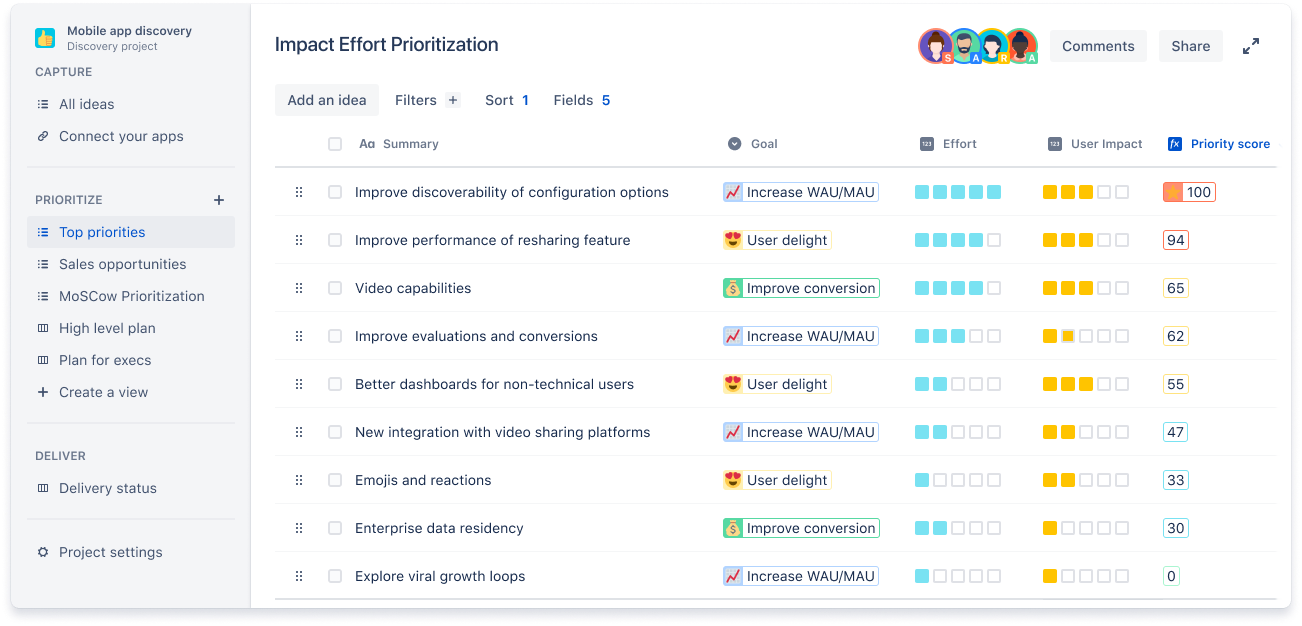
Figure 2
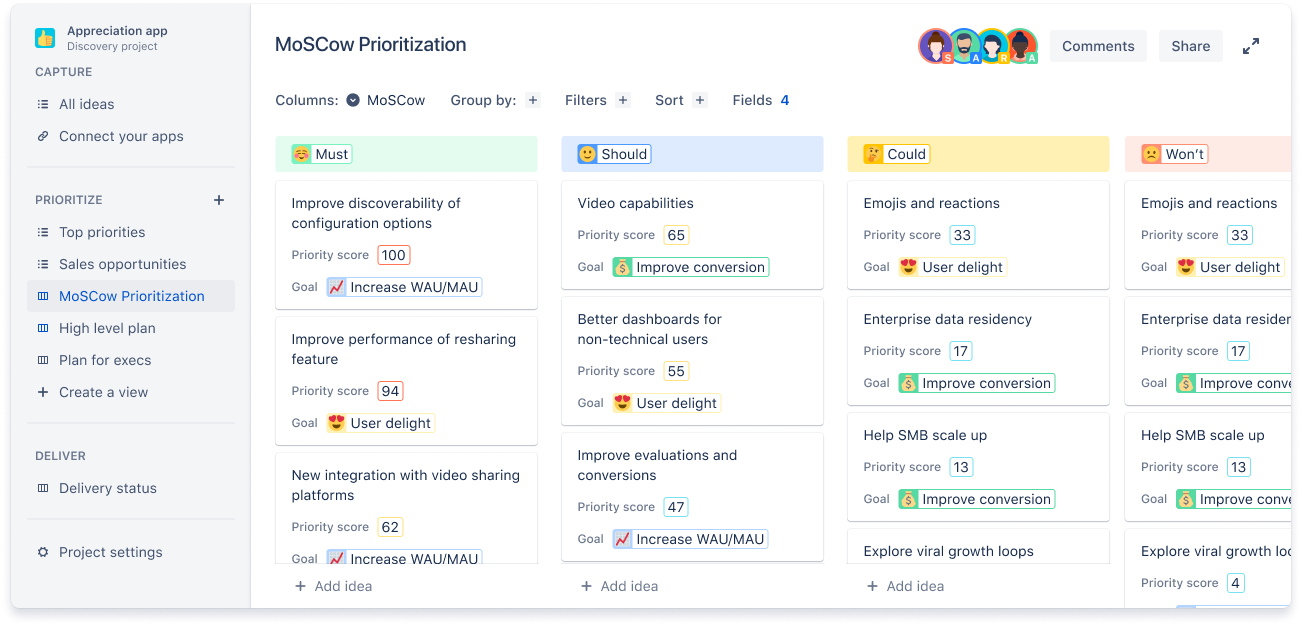
Requirement 3: Open collaboration and robust visualization to drive engagement, alignment, and buy-in.
Not only does dynamic product discovery need to be transparent and collaborative, it needs to be engaging by providing views of information tailored to the needs of different stakeholders. For example, delivery teams need clear direction on where to focus resources and efforts, and a kanban- style now/next/later is a preferred way to communicate priorities. However, a sales or customer support team may want the same data presented against their priorities and delivery status. An executive team may want to see a strategic view of the data based on it’s impact on OKRs. The flexible and contrasting views of the same information is shown in figures 3, 4, and 5 below.
Figure 3. A kanban view of the plan
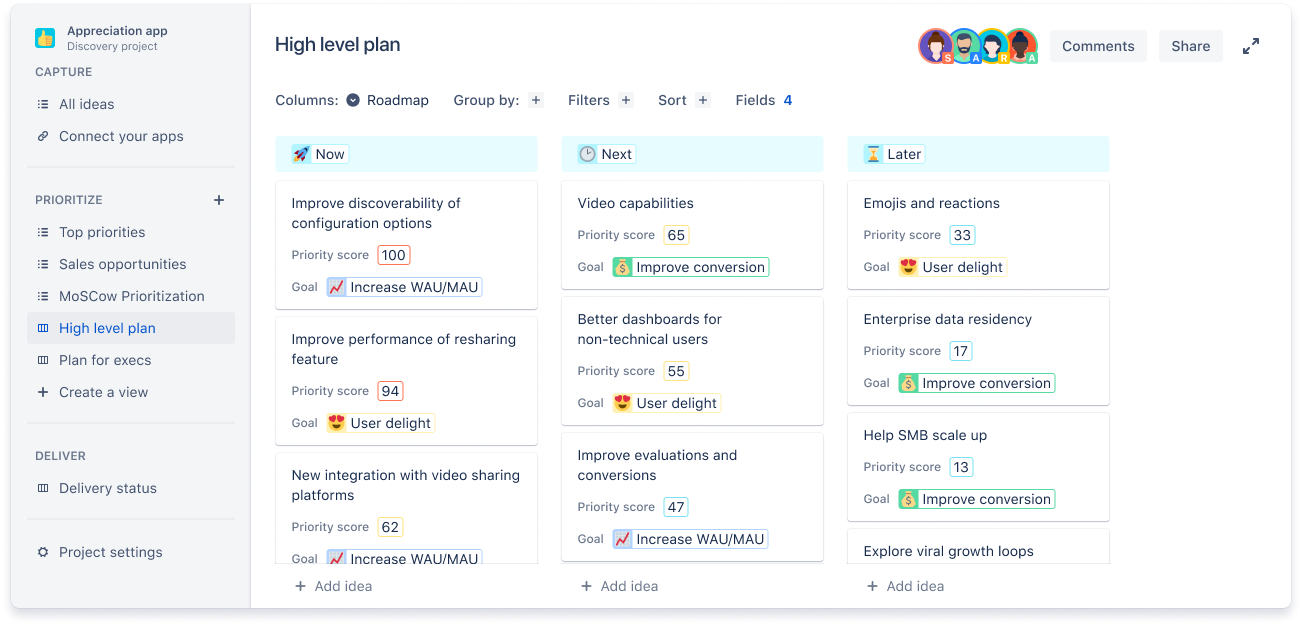
Figure 4. A sales view with themes and delivery status
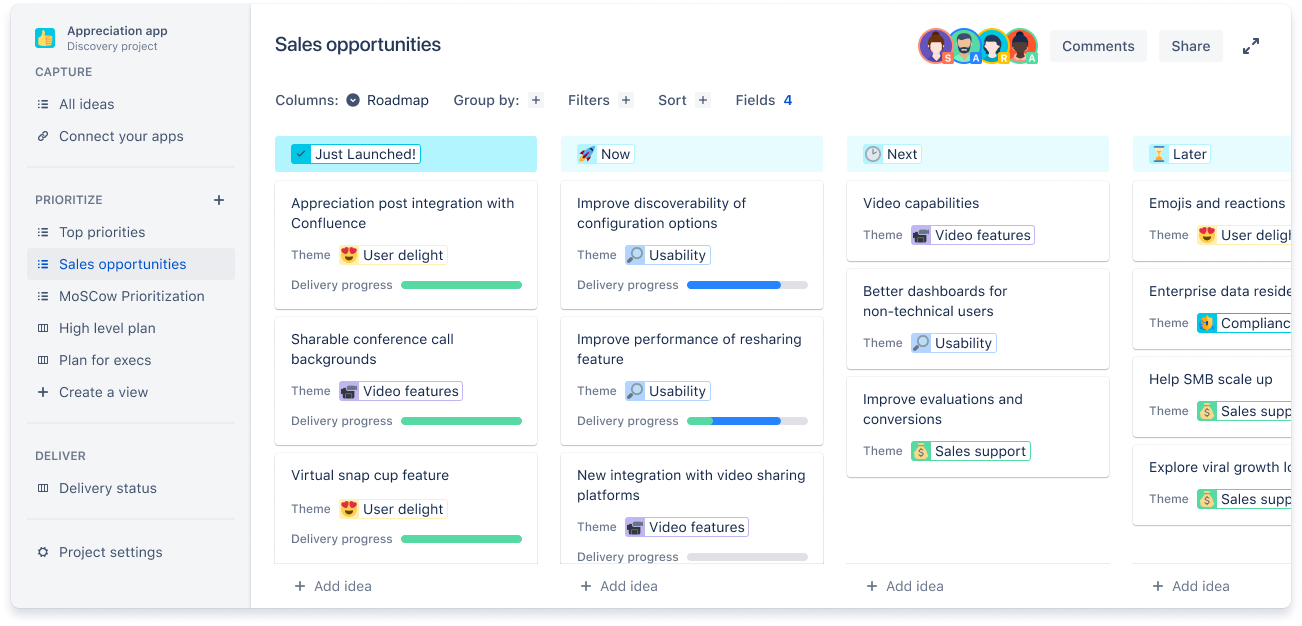
Figure 5. An executive view based on company goals
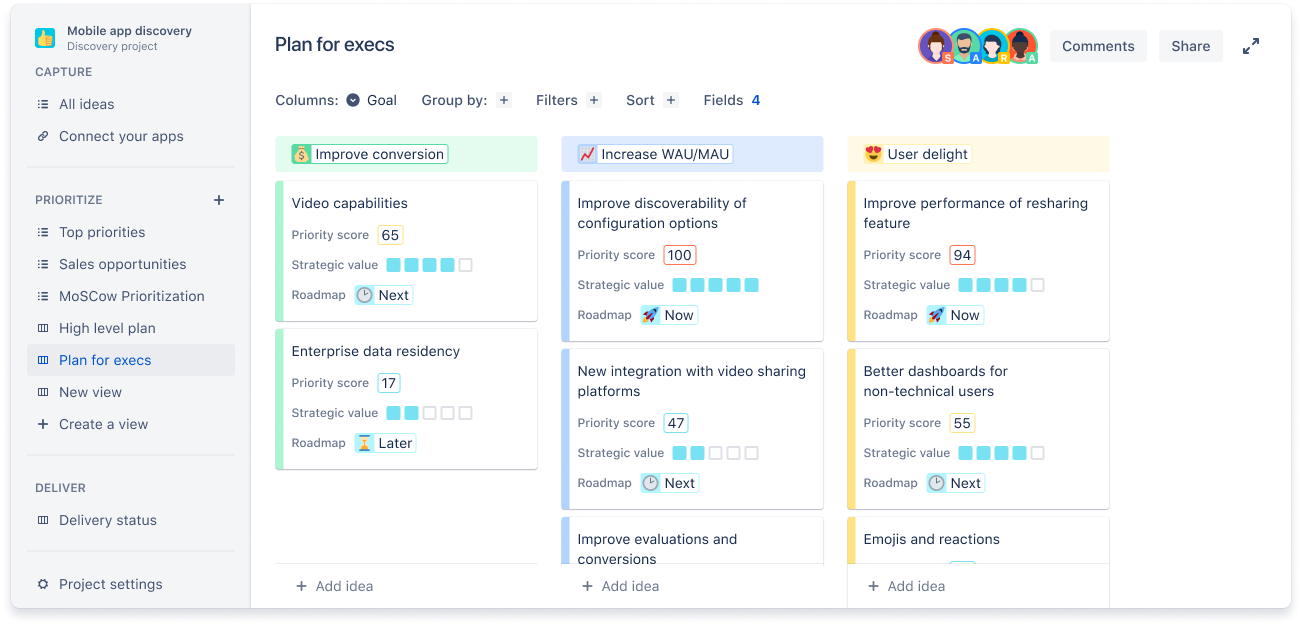
By involving stakeholders appropriately throughout the product discovery process, and by presenting data to them in appropriate and understandable ways, product managers can leverage dynamic product discovery to create buy-in on decisions and alignment in action.
Requirement 4: Easily incorporate customer and user feedback
Customer and user feedback is at the heart of dynamic product discovery. This feedback can come from existing systems such as product analytics, customer feedback, support, and the formal and informal discussions product managers have with users.
Requirement 5: Seamless integration with delivery to facilitate agile productization
Dynamic product discovery does not stop with one-time prioritization and passing of a roadmap to delivery. In fact, dynamic product discovery must be integrated directly with delivery at a data, process, and tool level to share beyond simple priorities to include the data and reasoning behind the decisions and to feed new data back to Product Management on delivery status, so Product Management can continuously revisit priorities, adjust them accordingly. Integration with delivery should also facilitate the communication of changes and the reasons behind these changes to stakeholders across the organization,to keep the entire organization aligned. Not just on decisions, but also the status of execution and changes to these decisions.
Dynamic product discovery: Ideas to product success
In today’s fast-paced markets, where the premium is on delivering the best product possible for the customer, and innovating constantly to stay ahead of competition, the data-driven and integrated process of dynamic product discovery is a must-have to help product teams transform ideas into product success.
But having the data and the prioritization process is not enough. Dynamic product discovery helps product managers create alignment and buy-in within the product team and with other organizational stakeholders, from customer facing teams to executives. Because dynamic product discovery is open, collaborative, and transparent, it minimizes surprises and miscommunication, and misunderstandings.
And when decisions are driven by data with an open and collaborative process such as Dynamic product discovery, the Product Managers are more confident in their decisions. They are both self and organizationally empowered to drive product success, and they are seen not just as competent, but as impactful leaders.
Dynamic product discovery, Leadership, Teamwork, and Success
For many years, a popular paradigm of leadership for the product manager was that of CEO. However this paradigm has given way to a more flexible and dynamic view of leadership. The product manager who is a dynamic leader is a team member, not the boss, they are obsessed with product success and their authority is earned on the “playing field” not given by flat organizations. The dynamic leader focuses not just on business strategy and quarterly results, but on continuous “game time” decisions.
|
| The old way: Product manager as the CEO | The new way: Product manager as the dynamic leader |
| Self image | Boss | Team leader (among equals) |
| Obsession | Business strategy | Customer and product success |
| Focus | Time-bound, quarterly results | Continuous, game-time decisions |
| Authority model | Hierarchical and formal (given by organization) | Flat and earned (through “playing on the field”) |
| Leadership style | Autocratic and formal | Varies |
Dynamic leadership paired with dynamic product discovery is a powerful approach to being an empowered and successful product leader.
In conclusion…
Jira Product Discovery is Atlassian’s Dynamic product discovery product that empowers product managers to lead their teams to transform ideas to product success. Product Managers who adopt Jira Product Discovery leverage data, process, and their personal leadership style to guide product teams in defining, building, and delivering products that customers love and that achieve the strategic objectives of the business.
Jira Product Discovery is an integrated and collaborative Dynamic product discovery product that provides comprehensive data capture, flexible prioritization, and dynamic engagement and is fully integrated with Jira Software, to close the loop from product discovery to Delivery and back as shown below.
Jira connects your entire workflow; from discovery to delivery
Jira Product Discovery provides product managers with a powerful and flexible capability to manage and succeed in Dynamic product discovery, answering the four key discovery questions enabling data driven prioritization, engagement and integration with delivery. Only Jira Product Discovery keeps ideas, data, and the extended product team together in the familiar Jira environment. It enables the new Dynamic product leaders to effectively lead the team in transforming ideas to Product Success, while collaborating and engaging with their team and beyond. Product managers can utilize Jira Product Discovery to help them become recognized, confident, and empowered leaders across the organization.
And Jira Product Discovery is free to try, so visit www.atlassian.com/software/jira/product-discovery and see how Jira Product Discovery can help you lead your team to Product success.


@2x.png?cdnVersion=1581)
@2x.png?cdnVersion=1581)